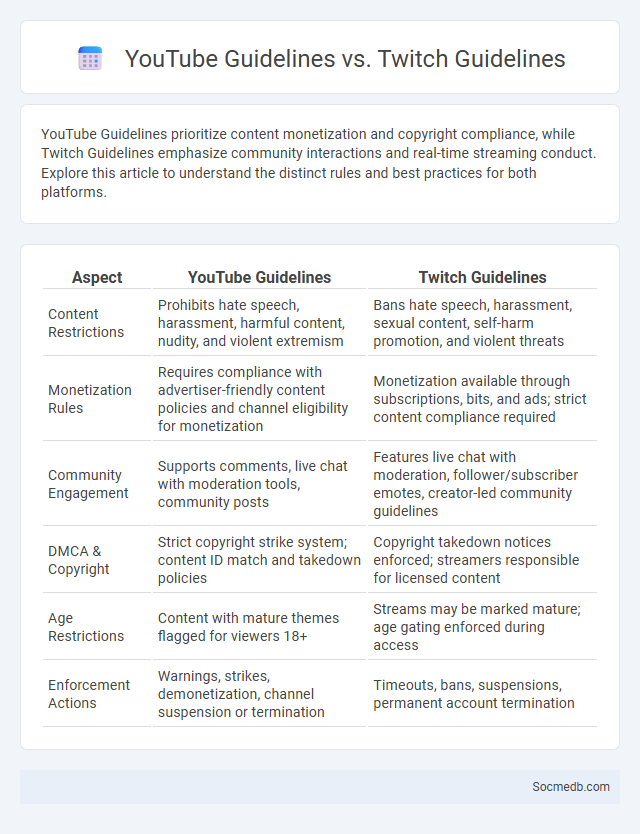
Photo illustration: YouTube Guidelines vs Twitch Guidelines
YouTube Guidelines prioritize content monetization and copyright compliance, while Twitch Guidelines emphasize community interactions and real-time streaming conduct. Explore this article to understand the distinct rules and best practices for both platforms.
Table of Comparison
| Aspect | YouTube Guidelines | Twitch Guidelines |
|---|---|---|
| Content Restrictions | Prohibits hate speech, harassment, harmful content, nudity, and violent extremism | Bans hate speech, harassment, sexual content, self-harm promotion, and violent threats |
| Monetization Rules | Requires compliance with advertiser-friendly content policies and channel eligibility for monetization | Monetization available through subscriptions, bits, and ads; strict content compliance required |
| Community Engagement | Supports comments, live chat with moderation tools, community posts | Features live chat with moderation, follower/subscriber emotes, creator-led community guidelines |
| DMCA & Copyright | Strict copyright strike system; content ID match and takedown policies | Copyright takedown notices enforced; streamers responsible for licensed content |
| Age Restrictions | Content with mature themes flagged for viewers 18+ | Streams may be marked mature; age gating enforced during access |
| Enforcement Actions | Warnings, strikes, demonetization, channel suspension or termination | Timeouts, bans, suspensions, permanent account termination |
Overview: YouTube and Twitch Platform Guidelines
YouTube and Twitch maintain strict platform guidelines to ensure safe and respectful communities, emphasizing content originality, copyright compliance, and prohibiting hate speech or harmful behavior. You must adhere to specific rules regarding content monetization, user interactions, and live streaming conduct to avoid penalties or account suspension. Understanding and following these guidelines protects your channel's reputation and fosters a positive viewer experience.
Key Differences between YouTube and Twitch Policies
YouTube's policies prioritize a broad range of content types with strict guidelines on copyright, community standards, and monetization eligibility, whereas Twitch focuses primarily on live streaming with rules targeting real-time interactions, chat behavior, and content appropriateness. YouTube uses automated systems alongside manual review to enforce policies, while Twitch emphasizes moderator roles and viewer reporting to manage community conduct. To avoid violations and ensure your content thrives, you must understand and adhere to each platform's specific rules regarding prohibited content and user engagement.
Content Moderation Approaches Compared
Content moderation approaches vary widely, including automated algorithms, human moderators, and hybrid models that combine both. Automated systems use machine learning to detect harmful content quickly but may struggle with context nuances, while human moderators provide better judgment yet face scalability challenges. Hybrid approaches balance efficiency and accuracy, leveraging AI for initial filtering and human review for complex cases to ensure safer online environments.
Community Standards: YouTube vs Twitch
YouTube's Community Standards enforce strict policies against hate speech, harassment, and harmful content to maintain a safe environment, with automated systems and human reviewers actively moderating content. Twitch emphasizes real-time moderation through community reporting and channel moderators, focusing on preventing disruptive behavior during live streams and promoting positive interaction. Understanding these differences helps Your approach to content creation stay compliant and respectful across platforms.
Monetization Rules: YouTube vs Twitch
YouTube monetization requires creators to have at least 1,000 subscribers and 4,000 watch hours in the past 12 months to join the YouTube Partner Program, enabling ad revenue, channel memberships, and Super Chats. Twitch monetization offers the Affiliate and Partner programs, with Affiliates needing 50 followers and at least 500 total minutes broadcast in 7 unique days within 30 days, providing income through subscriptions, Bits, and ads. Both platforms impose specific content guidelines and revenue-sharing models, with YouTube typically taking a 45% ad revenue cut, while Twitch splits subscription revenue 50/50, influencing creators' income strategies.
Demonetization: Triggers and Consequences
Demonetization on social media is primarily triggered by violations of platform policies such as copyright infringement, inappropriate content, or misinformation. These actions result in reduced revenue streams for creators through ad revenue suppression, limited access to monetization features, or suspension of accounts. The consequences include diminished content quality, loss of audience engagement, and a shift towards alternative monetization methods like sponsorships or merchandise sales.
Graphic Content and Language Restrictions
Social media platforms enforce strict graphic content and language restrictions to maintain community guidelines and ensure user safety. Explicit violence, nudity, hate speech, and abusive language are routinely flagged and removed through automated systems and human moderation. These policies are designed to promote respectful interactions and prevent harmful or offensive content from spreading widely.
Handling Copyright and DMCA on Both Platforms
Handling copyright and DMCA on social media platforms requires vigilance in identifying and removing infringing content to avoid legal penalties. You must carefully review platform-specific copyright policies and promptly respond to DMCA takedown notices to protect your content rights. Implementing automated tools to monitor unauthorized use can streamline enforcement and maintain compliance across all major social media networks.
Enforcement and Appeals: What Creators Face
Creators on social media often encounter strict enforcement policies that can result in content removal, demonetization, or account suspension due to violations of platform guidelines. These enforcement actions challenge creators to carefully navigate the rules while maintaining engagement and authenticity. Your ability to successfully appeal decisions depends on understanding platform-specific appeal processes and providing clear evidence that content complies with community standards.
Evolving Guidelines: Trends and Future Implications
Social media guidelines are increasingly adapting to address issues like data privacy, misinformation, and user safety, reflecting evolving digital norms and regulatory frameworks. Emerging trends emphasize transparent content moderation, algorithmic accountability, and enhanced user empowerment tools to foster healthier online environments. Future implications suggest stricter compliance requirements for platforms and a shift towards more ethical AI deployment to safeguard digital communities.
 socmedb.com
socmedb.com